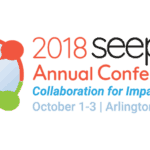‘Inequality Limits Growth … and You Get What You Incent’: Takeaways from Day 1 of the SEEP Network’s Annual Conference
SEEP’s 2016 conference, themed “Expanding Market Frontiers,” continues today in Washington, D.C. NextBillion editor Kyle Poplin is there, and he compiled some of the things he found most interesting during Tuesday’s sessions.
Tuesday began with a hot topic, “The Inequality Debate: Inclusive Development in the Context of Growing Income Disparities,” and the panel didn’t disappoint. Gawain Kripke of Oxfam America pointed out a well-worn statistic that hasn’t lost its power: The world’s 85 richest people have the same amount of wealth as the 3.5 billion poorest. “This is weird and grotesque,” he said, and no one disagreed.
What made it interesting — and different from, say, a U.S. presidential debate — was that a discussion followed about how to fix the income disparity. Gawain said Oxfam suggests tackling the issue with a four-pillar approach — fair tax policy, public services, fair wages and nondiscrimination — and is trying to shift the debate to these four areas.
He also asked uncomfortable questions about the role of financial service providers and final inclusion efforts in rising inequality. Panelist Christopher Musoke of Uganda Ltd. provided an answer, at first jokingly wondering if anything short of taking up arms and starting a revolution would solve things, then saying some financial service providers are taking advantage of loopholes that need to be closed through better consumer protections. And more competition wouldn’t hurt.
Someone from the audience suggested the conversation should be more racially diverse, and Gawain added that it should also include more people from varied economic backgrounds. Equality is natural, he summarized, and the product of growth; therefore, limiting inequality leads to growth. When people understand that, he said, they might be more willing to accept redistributive policies like taxing wealth and making government services free. Nurul Amin Siddiquee of CARE USA concurred, saying low public investment leads to income inequality.
‘You get what you incent’
A panel about financial literacy, capability and health got going when the Q&A session began. First, though, there was a helpful definition of terms: moderator Sonja Kelly of the Center for Financial Inclusion said that, in plain English, they were discussing what people know about money, what they do with it and what they can achieve if they have access to it.
The conversation took an ethical turn when someone asked if financial services providers in developing countries have an inherent conflict of interest. Elisabeth Rhyne of Accion unflinchingly answered yes, “they absolutely have a conflict — and an alignment — of interest.”
That got Sarah Parker of the Center for Financial Services Innovation (CFSI) started on Wells Fargo, where thousands of employees, seeking bonuses, secretly opened millions of fake bank and credit card accounts at customers’ expense. Wells Fargo single-handedly changed the discussion, she said, from the time-honored “what’s measured is what matters” to “you get what you incent. … Incentives drive behavior.”
Bankers don’t necessarily think of themselves as professionals or as having a professional ethic, Rhyne said, adding, “Wouldn’t it be wonderful if (they) became more concerned with the financial well-being of clients?”
But the “circle of responsibility” of financial institutions is limited, Parker said. Just as doctors can tell patients not to smoke, and some patients won’t listen, a “financial institution has only so much impact and responsibility on the ultimate financial health of customers. There will be behaviors you can’t always control,” like drought, community suffering, political unrest, and even self confidence, risk tolerance and perseverance. “There are a lot of things that make it very messy,” she said. “There’s lots of progress to be made before we focus on all the circles of things” that influence someone’s financial well-being.
The panel even broached the topic of financial education in schools. Rhyne said there’s been an overemphasis on economics vs. people’s behavioral characteristics. For example, knowledge of compound interest is not necessarily a good marker of being financially healthy, she said, while knowing you need to save and set something aside is.
‘It’s a lending issue, not a microlending issue’
The focus on ethics continued in a day-ending discussion about data and microloans for the poor. The question that got it started: Is it good for lenders to keep striving to give bigger loans to some of the world’s poorest people, putting them in financial jeopardy? Xavier Faz, of the think tank CGAP, said there’s a sweet spot somewhere in the process, where the borrower gets all he needs and can pay it back. “It’s not clear what that point is,” he said, but the good news is that the use of innovative new data sets, generated by new collection methods, will help find it. He admitted, however, that the incentive for microlenders is to keep pushing, keep lending, until the borrower’s “portfolio deteriorates.”
Other aspects of the lending business have gone through a similar process of finding that sweet spot, he said. “The only difference is this is happening very fast with lots of people. It’s happening at very high speed. It’s something to watch out for and we talk about it. But it’s a lending issue, not a microlending issue.”
Photo: Mercy Niwe of World Vision International participates in an interactive session at SEEP, “Applying a Market Development Approach to Financial Inclusion — Lessons from DRC.”
Note: NextBillion is a media partner for the SEEP Annual Conference, and Accion and CFSI are NextBillion content partners.
- Categories
- Social Enterprise



